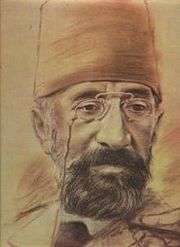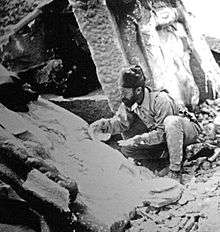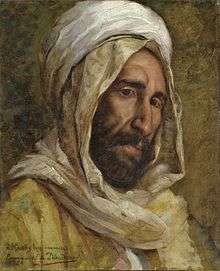Osman Hamdi Bey
| Osman Hamdi Bey | |
|---|---|
 Osman Hamdi Bey | |
| Born |
Osman Hamdi 30 December 1842 Konstantiniyye |
| Died |
24 February 1910 (Aged 68) Konstantiniyye |
| Nationality | Ottoman Turk |
| Known for | Painting, archaeology |
| Notable work | The Tortoise Trainer |
Osman Hamdi Bey (30 December 1842 – 24 February 1910) was an Ottoman administrator, intellectual, art expert and also a prominent and pioneering painter. He was also an accomplished archaeologist, and is regarded as the pioneer of the museum curator's profession in Turkey. He was the founder of Istanbul Archaeology Museums and of Istanbul Academy of Fine Arts (Sanayi-i Nefise Mektebi in Turkish), known today as the Mimar Sinan University of Fine Arts.
Early life

Osman Hamdi was the son of İbrahim Edhem Pasha,[1] an Ottoman Grand Vizier (in office 1877–1878, replacing Midhat Pasha) who was originally a Greek boy from the Ottoman island of Sakız (Chios) orphaned at a very young age[2] following the Chios massacre there.[3] He was adopted by Kaptan-ı Derya (Grand Admiral) Hüsrev Pasha[4] and eventually rose to the ranks of the ruling class of the Ottoman Empire.
Osman Hamdi went to primary school in the popular Istanbul quarter of Beşiktaş;[5] after which he studied Law, first in Istanbul (1856) and then in Paris (1860). However, he decided to pursue his interest in painting instead, left the Law program, and trained under French orientalist painters Jean-Léon Gérôme and Gustave Boulanger.[6] During his nine-year stay in Paris, the international capital of fine arts at the time, he showed a keen interest for the artistic events of his day.


His stay in Paris was also marked by the first ever visit by an Ottoman sultan to Western Europe, when Sultan Abdülaziz was invited to the Exposition Universelle (1867) by Emperor Napoleon III. He also met many of the Young Ottomans in Paris, and even though he was exposed to their liberal ideas, he did not participate in their political activities, being the son of an Ottoman pasha who was loyal to the sultan and did not challenge the old absolutist system. Osman Hamdi Bey also met his first wife Maria, a French woman, in Paris when he was a student. After receiving his father's blessings, she accompanied him to Istanbul (Constantinople) when he returned in 1869, where the two got married and had two daughters.
Once back in Turkey, he was sent to the Ottoman province of Baghdad as part of the administrative team of Midhat Pasha, who would later become an important reformer and the leading political figure among the Young Ottomans who enacted the First Ottoman Constitution in 1876.[8] In 1871, Osman Hamdi returned to Istanbul, as the vice-director of the Protocol Office of the Palace. During the 1870s, he worked on several assignments in the upper echelons of the Ottoman bureaucracy.
Career


Osman Hamdi exhibited three paintings at the 1867 Paris Exposition Universelle.[8] None seem to have survived today, but their titles were Repose of the Gypsies, Black Sea Soldier Lying in Wait, and Death of the Soldier. An important step in his career was his assignment as the director of the Imperial Museum (Müze-i Hümayun) in 1881. He used his position as museum director to develop the museum and rewrite the antiquities laws and to create nationally sponsored archaeological expeditions. In 1882, he instituted and became director of the Academy of Fine Arts, which provided Ottomans with training in aesthetics and artistic techniques without leaving the empire.[9] In 1884, he oversaw the promulgation of a Regulation prohibiting historical artifacts from being smuggled abroad (Asar-ı Atîka Nizamnamesi), a giant step in constituting a legal framework of preservation of the antiquities. Representatives or middlemen of 19th-century European Powers routinely smuggled artifacts with historical value from within the boundaries of the Ottoman Empire (which then comprised the geographies of ancient Greek and Mesopotamian civilizations, among others), often resorting to shadily obtained licenses or bribes, to enrich museums in European capitals.
He conducted the first scientific based archaeological researches done by a Turkish team. His digs included sites as varied as the Commagene tomb-sanctuary in Nemrut Dağı in southeastern Anatolia (a top tourist's venue in Turkey and a UNESCO World Heritage Site today, within the Adıyaman Province), the Hekate sanctuary in Lagina in southwestern Anatolia (much less visited, and within the Muğla Province today), and Sidon in Lebanon. The sarcophagi he discovered in Sidon (including the one known as the Alexander Sarcophagus, although this sarcophagus is thought to contain the remains of either Abdalonymus, King of Sidon; or Mazaeus, a Persian noble who was also the governor of Babylon) are considered among the worldwide jewels of archaeological findings. To lodge these, he started building what is today the Istanbul Archaeology Museum in 1881. The museum officially opened in 1891 under his directorship.
Throughout his professional career as museum and academy director, Osman Hamdi continued to paint in the style of his teachers, Gérôme and Boulanger.
The Tortoise Trainer

His 1906 painting, The Tortoise Trainer, broke a record in Turkey[10] by being sold for the amount of 3.5 million dollars in December 2004. The painting expresses a sarcastic innuendo on the painter's own view of his style of work compared to those of his collaborators and apprentices, and is also a reference to the historical fact of tortoises having been employed for illuminative and decorative purposes, by placing candles on the shell, in evening outings during the Tulip Era in the early 18th century. The painting was acquired by the Suna and İnan Kıraç Foundation and is currently on display at the Pera Museum in İstanbul, which was established by this foundation.
Modern researchers have identified the animals portrayed are Testudo graeca ibera, a variety of the Spur-thighed Tortoise. A reproduction of the painting appeared on the cover of the Bibliotheca Herpetologica issue in which the paper about the identification was published.[11]
Gallery
 The Tortoise Trainer (1906)
The Tortoise Trainer (1906) (1910)
(1910) (1910)
(1910) Naile Hanım (1910)
Naile Hanım (1910) (1908)
(1908) Mihrab (1901)
Mihrab (1901) Two Young Girls visiting a Türbe (1890)
Two Young Girls visiting a Türbe (1890) (1887)
(1887) (1882)
(1882) (1880)
(1880) (1881)
(1881) (1881)
(1881).jpg) (1879)
(1879)
Paintings at the Pera Museum, Istanbul

 Kökenoğlu Rıza Efendi (1871)
Kökenoğlu Rıza Efendi (1871) Girl with Pink Cap (June 1904)
Girl with Pink Cap (June 1904) Two Musician Girls (1880)
Two Musician Girls (1880)
Family
- His daughter Nazlı Hamdi (1893–1958)[12] married an Ottoman diplomat, Esat Cemil Bey, in 1912, and the couple had one daughter, Cenan Hamdi Sarç, who lived 99 years and died in 2012.[13] Cenan Hamdi married Ömer Celal Sarç, who was the rector of Istanbul University in 1932. She had one son, Faruk Sarç, who was born in 1933.
- He was the brother of Halil Edhem Eldem, who became the Director of the Istanbul Archaeology Museums after his death, and served as a Member of Parliament at the Grand National Assembly of Turkey for ten years under the newly founded Turkish Republic.
- He was the brother of İsmail Galib Bey, considered the founder of numismatics as a scientific discipline in Turkey.
- He was the granduncle of Sedad Hakkı Eldem, a renowned Turkish architect.
- He was the granduncle of Cemal Reşit Rey, one of the five pioneers of classical music in Turkey (termed the Turkish Five.)
References and notes

- ↑ Shaw, Wendy M. K. Possessors and possessed: museums, archaeology, and the visualization of history in the late Ottoman Empire. University of California Press. p. 2003. ISBN 0-520-23335-2.
(Osman Hamdi)…His father, Ibrahim Edhem, was born in the Greek Orthodox village of Sakiz. After being captured as a prisoner of war during a village revolt, he was sold as a slave to the chief naval officer, Kaptan-ı Derya Hüsrev Pasha, the head of the Ottoman Navy, who would also soon serve as vizier to the sultan.
- ↑ Shankland, David (2004). Archaeology, anthropology, and heritage in the Balkans and Anatolia: the life and times of F.W. Hasluck, 1878–1920. Isis Press. p. 125. ISBN 975-428-280-3.
Osman Hamdi Bey's father, Edhem Pasha (ca. 1818–1893) was a high official of the Empire. A Greek boy captured on Chios after the 1822 massacres, he was acquired and brought up by Hüsrev Pasha, who sent him to Paris in 1831 in order to acquire a western education.
- ↑ Littell, Eliakim (1888). The Living age. The Living Age Co. p. 614. OCLC 10173561.
Edhem Pasha was a Greek by birth, pure and unadulterated, having when an infant been stolen from the island of Chios at the time of the great massacre there
- ↑ "Kaplumbağa Terbiyecisi", Osman Hamdi Bey'in Romanı, Emre Can, Kapı Yayınları, 2008, pp 200–201
- ↑ The Encyclopædia Britannica, Vol.7, Edited by Hugh Chisholm, (1911), 3; "Constantinople, the capital of the Turkish Empire...".
- ↑ Wendy M.K. Shaw, Possessors and Possessed: Museums, Archaeology, and visualisation of history in the late Ottoman Empire. University of California Press 2003, p. 98 ISBN 0-520-23335-2
- 1 2 3 4 "Aşık olduğu iki kadının adı da Marie'ydi...", Posta.com.tr, 11 October 2010.
- 1 2 W. Shaw, p. 98
- ↑ W. Shaw, p. 99
- ↑ "Osman Hamdi's 'lost' masterpiece in auction". Retrieved 22 May 2015.
- ↑ Bettelheim, Matthew P. and Ertan Taskavak. 2006. The Tortoise and the Tulip – Testudo graeca ibera and Osman Hamdi's "The Tortoise Trainer". Bibliotheca Herpetologica. 6(2): pp 11–15. The paper is mentioned, and the magazine cover is shown, at ISHBH publication list
- ↑ ""NAZLI'NIN DEFTERİ, OSMAN HAMDİ BEY'İN ÇEVRESİ" SERGİSİ ANAMED'DE AÇILIYOR.". aktuelarkeoloji.com.tr. Retrieved 1 December 2015.
- ↑ "Kızı Nazlı'nın defterinden Osman Hamdi Bey'in dostları". ZAMAN. 2014-04-28. Retrieved 2014-08-26.
Biography
- "Kaplumbağa Terbiyecisi", Osman Hamdi Bey'in Romanı, Emre Can, Kapı Yayınları, 2008.
- "L'ammaestratore di Istanbul", Elettra Stamboulis & Gianluca Costantini, Comma 22, 2008.
- "L'ammaestratore di Istanbul", Elettra Stamboulis & Gianluca Costantini, Giuda Edizioni, 2013.
Documentary films
- Osman Hamdi Bey: Kaplumbağa Terbiyecisi (Osman Hamdi Bey: The Tortoise Trainer) is a 2012 documentary film about the life and works of Osman Hamdi Bey, directed by Umut Hacıfevzioğlu.[1]
External links
- The Turtle Tamer of Istanbul Graphic Novel
 Media related to Osman Hamdi Bey at Wikimedia Commons
Media related to Osman Hamdi Bey at Wikimedia Commons
- ↑ Osman Hamdi Bey: Kaplumbağa Terbiyecisi, Filmeks, 2012-04-18, retrieved 2016-03-18